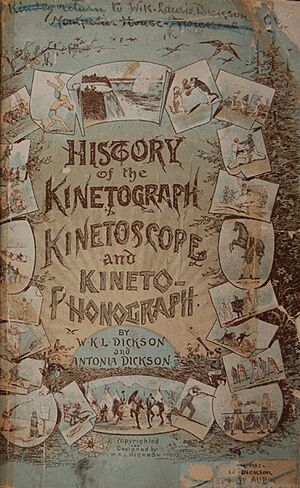History of the Kinetograph, Kinetoscope, and Kinetophonograph facts for kids
 |
|
| Author |
|
|---|---|
| Illustrator | William Kennedy Dickson |
| Country | United States |
| Language | English |
| Genre | History |
| Published | 1895 |
| Publisher | Museum of Modern Art |
| Pages | 55 |
| OCLC | 82046841 |
History of the Kinetograph, Kinetoscope, and Kinetophonograph is a special book about the early days of movies. It was written by a brother and sister, William Kennedy Dickson and Antonia Dickson. William worked with the famous inventor Thomas Edison. He helped create some of the first machines that could record and show moving pictures.
This book talks a lot about these amazing inventions: the kinetograph, the kinetoscope, and the kinetophonograph. These were super important for making movies possible! Many people think this was the very first history book ever written about film. It came out in 1895. The Museum of Modern Art bought the book in 1940. They even printed new copies in 1970 and 2000. Experts who study books and movies really liked it. They said it was a great way to learn about how the movie industry started.
Contents
How the Book Was Made and What's Inside
The Authors and Their Work
History of the Kinetograph, Kinetoscope, and Kinetophonograph is a collection of writings. It tells the story of how movies began. The authors are William Kennedy Dickson, who was a pioneer in filmmaking, and his sister, Antonia Dickson, a science writer.
The Dicksons lived in England before moving to the United States in 1879. In 1883, when William was 23, he started working for Thomas Edison. He joined Edison's company, Edison Machine Works, in New York City.
Developing Early Movie Machines
In 1888, Thomas Edison asked William Dickson to help create a new machine. This machine would become the kinetoscope. It was one of the first ways to play back motion picture films. William later moved to Edison's "Black Maria" film studio. This studio was in West Orange, New Jersey. Most of the book shares William's experiences working at this important studio.
What You'll Find in the Book
This book is 55 pages long. It has 54 drawings made by William himself. It explains how the very first movie cameras worked. It also shows how early films were shown to people. The book focuses on three main inventions:
- The kinetograph: This machine was used to capture pictures on film.
- The kinetoscope: This machine played films back for people to watch.
- The kinetophonograph: This amazing machine combined pictures with sound!
William Dickson worked closely with Edison to develop all these devices. Antonia and William also gave credit to other people who helped create film. They mentioned the actors and subjects who appeared in these early movies. The book even starts with a special introduction written by Thomas Edison himself.

